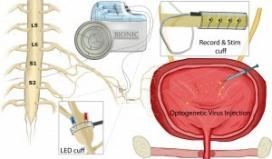ERC-led Team Awarded $1M Bioelectronics Innovation Prize
An international team led by researchers atthe Center for Sensorimotor Neural Engineering (CSNE), an NSF-funded Engineering Research Center (ERC) headquartered at the University of Washington (UW), is one of three finalists in a competition to produce an implantable wireless device that can assess, stimulate, and block the activity of nerves that control organs. For the GlaxoSmithKline Bioelectronics Innovation Challenge, the team is developing an implantable device that could help restore bladder function for people with spinal cord injuries or millions of others who suffer from incontinence. The team has been awarded $1 million to pursue this effort.
“For people with spinal cord injuries, restoring sexual function and bladder function are some of their top priorities—higher than regaining the ability to walk,” said Chet Moritz, deputy director of the CSNE and UW associate professor of rehabilitation medicine and of physiology and biophysics. The CSNE team—one of 12 initially selected by GlaxoSmithKline to compete in the challenge—joined forces with another team of experts from the University of Cambridge and University College London for the second round of the competition. The company will award up to $1 million in additional research funding to each team in this second round. Another $1 million prize will go to the first group to deliver a device that is functional in small animal models.
The competition’s driving concept is to replace pharmaceuticals, which can affect many systems throughout the body, with wireless devices that enable much more targeted interventions by stimulating or blocking the activity of specific nerves that send signals to organs. These devices could also “read” how the organs are functioning and decide whether any treatment action is necessary at that moment.
The CSNE team’s final implantable wireless device will be able to stimulate and block electrical signals that travel along the nerves and control specific organs. Stimulating the pelvic nerve causes the bladder to empty, for example, while blocking those signals could help someone who is unable to control his or her bladder.
However, numerous challenges persist—such as delivering power efficiently and without wires while ensuring that the implanted device doesn’t overheat inside the body, and limiting tissue reactions at the nerve interface.
The CSNE team at UW is using a wireless power transmitter developed by CSNE leader and UW associate professor of electrical engineering and of computer science and engineering Joshua Smith. A similar technology is being used by Smith’s new company, WiBotic Corp., to manufacture wireless power systems for robots and drones.
They designed the wireless device to interact with a rat’s pelvic nerve in one of two ways—both electronically and optically. Moritz and team member Greg Horwitz, UW associate professor of physiology and biophysics, have expertise in optogenetics, which uses light to control neurons. That approach may enable the team to stimulate the pelvic nerve without having to physically touch it, which may reduce swelling and scarring that can occur with direct nerve interfaces.
The University of Cambridge and University College of London researchers have deep expertise in nerve and bladder physiology, as well as packaging implantable devices so they don’t corrode or break down in the body’s moist and dynamic environment.
After the competition concludes, the next steps will be to disseminate the technologies to the wider research community and begin working on human trials. The goal is to create a flexible platform that could act on a wide variety of organs.


